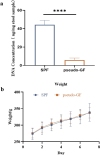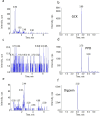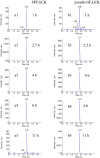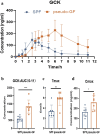In vivo pharmacokinetics of ginsenoside compound K mediated by gut microbiota
- PMID: 39178246
- PMCID: PMC11343376
- DOI: 10.1371/journal.pone.0307286
In vivo pharmacokinetics of ginsenoside compound K mediated by gut microbiota
Abstract
Ginsenoside Compound K (GCK) is the main metabolite of natural protopanaxadiol ginsenosides with diverse pharmacological effects. Gut microbiota contributes to the biotransformation of GCK, while the effect of gut microbiota on the pharmacokinetics of GCK in vivo remains unclear. To illustrate the role of gut microbiota in GCK metabolism in vivo, a systematic investigation of the pharmacokinetics of GCK in specific pathogen free (SPF) and pseudo-germ-free (pseudo-GF) rats were conducted. Pseudo-GF rats were treated with non-absorbable antibiotics. Liquid chromatography tandem mass spectrometry (LC-MS/MS) was validated for the quantification of GCK in rat plasma. Compared with SPF rats, the plasma concentration of GCK significantly increased after the gut microbiota depleted. The results showed that GCK absorption slowed down, Tmax delayed by 3.5 h, AUC0-11 increased by 1.3 times, CLz/F decreased by 0.6 times in pseudo-GF rats, and Cmax was 1.6 times higher than that of normal rats. The data indicated that gut microbiota played an important role in the pharmacokinetics of GCK in vivo.
Copyright: © 2024 Deng et al. This is an open access article distributed under the terms of the Creative Commons Attribution License, which permits unrestricted use, distribution, and reproduction in any medium, provided the original author and source are credited.
Conflict of interest statement
The authors have declared that no competing interests exist.
Figures





Similar articles
-
Quantification of Panax notoginseng saponins metabolites in rat plasma with in vivo gut microbiota-mediated biotransformation by HPLC-MS/MS.Chin J Nat Med. 2019 Mar;17(3):231-240. doi: 10.1016/S1875-5364(19)30026-3. Chin J Nat Med. 2019. PMID: 30910060
-
Biotransformation differences of ginsenoside compound K mediated by the gut microbiota from diabetic patients and healthy subjects.Chin J Nat Med. 2023 Oct;21(10):723-729. doi: 10.1016/S1875-5364(23)60402-9. Chin J Nat Med. 2023. PMID: 37879791
-
Metabolic characteristics of ginsenosides from Panax ginseng in rat feces mediated by gut microbiota.J Pharm Biomed Anal. 2024 Jan 5;237:115786. doi: 10.1016/j.jpba.2023.115786. Epub 2023 Oct 11. J Pharm Biomed Anal. 2024. PMID: 37837893
-
Gut microbiota in the pharmacokinetics and colonic deglycosylation metabolism of ginsenoside Rb1 in rats: Contrary effects of antimicrobials treatment and restraint stress.Chem Biol Interact. 2016 Oct 25;258:187-96. doi: 10.1016/j.cbi.2016.09.005. Epub 2016 Sep 6. Chem Biol Interact. 2016. PMID: 27613481
-
Gut microbiota-mediated pharmacokinetics of ginseng saponins.J Ginseng Res. 2018 Jul;42(3):255-263. doi: 10.1016/j.jgr.2017.04.011. Epub 2017 Apr 28. J Ginseng Res. 2018. PMID: 29983606 Free PMC article. Review.
Cited by
-
The Effects of Different Administration Regimens of Berberine Hydrochloride on the Pharmacokinetics of Sirolimus in Rats.Pharmacol Res Perspect. 2025 Jun;13(3):e70126. doi: 10.1002/prp2.70126. Pharmacol Res Perspect. 2025. PMID: 40396352 Free PMC article.
-
Gut microbiota and its metabolites regulate insulin resistance: traditional Chinese medicine insights for T2DM.Front Microbiol. 2025 Mar 19;16:1554189. doi: 10.3389/fmicb.2025.1554189. eCollection 2025. Front Microbiol. 2025. PMID: 40177494 Free PMC article. Review.
References
MeSH terms
Substances
LinkOut - more resources
Full Text Sources
Miscellaneous

